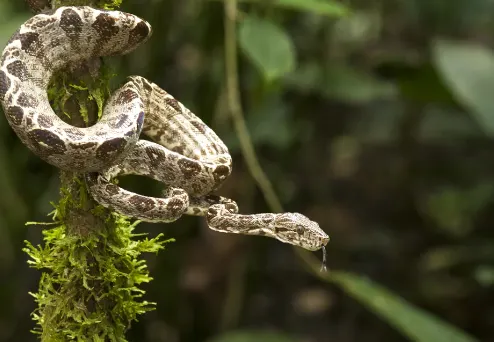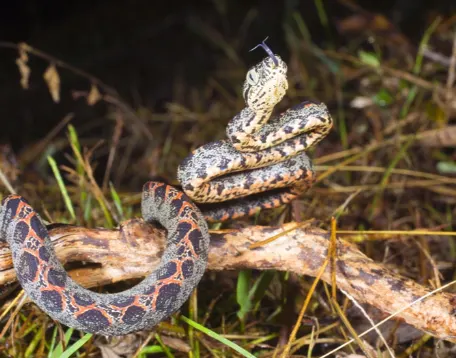The Amazon Tree Boa (Corallus hortulanus) is a captivating reptile native to the lush forests of South America. Known for its striking appearance and unique behaviors, this snake has become a favorite among herpetologists and reptile enthusiasts alike.
Table of Contents
Appearance and Color Phases
Amazon tree boas are celebrated for their vibrant color variations, which range from brown, grey, yellow, red, orange, to various shades of olive. These snakes exhibit two primary color phases: the garden phase, characterized by drab hues with intricate patterns, and the colored phase, showcasing vivid reds, oranges, and yellows. Unlike some other snakes, Amazon tree boas do not change color as they mature; they retain the colors they are born with throughout their lives.

Habitat and Distribution
These boas are primarily arboreal, spending most of their lives in the trees of the Amazon rainforest. They are found across a broad range, including Bolivia, Brazil, Colombia, Ecuador, Guyana, Peru, Surinam, and Venezuela. Their adaptability allows them to thrive in both dense forests and fruit tree plantations, from sea level up to altitudes of 3,000 meters.
Behavior and Hunting Techniques
Amazon tree boas are solitary and mostly nocturnal, although they can be active during the day. They are known for their aggression and are quick to strike when threatened. Despite this, their adaptability has made them a popular choice for experienced snake keepers.
Their hunting strategy is fascinating: they use their prehensile tails to hang from branches and stretch out, resembling a tree branch. This camouflage helps them ambush prey such as rats, mice, bats, lizards, frogs, and birds. Their heat-sensing pits located along their lips enable them to detect warm-blooded prey even in the dark.
Reproduction and Lifespan
These boas have a lifespan of over 15 years in captivity. They reach sexual maturity between two and five years of age, with females generally maturing later than males. Mating usually occurs between December and March, with females giving birth to live young—typically 4-10 neonates—after a gestation period of seven to ten months.
Conservation Status and Threats
Currently listed as “Least Concern” by the IUCN, Amazon tree boas are still common in the wild, although habitat destruction and over-harvesting for the pet trade pose localized threats. These snakes are highly dependent on forested environments, and deforestation could significantly impact their populations.
Captivity and Pet Trade
Amazon tree boas are often kept as pets, but their aggressive nature and specific care requirements make them unsuitable for novice snake keepers. Most of the individuals in the pet trade are wild-caught, though efforts are increasing to breed them in captivity. Handling these snakes requires caution due to their propensity to bite.

7 interesting facts about the Amazon Tree Boa
- Tail Prehensility: Beyond aiding in hunting, the Amazon Tree Boa’s tail is highly versatile. It can grasp branches, providing stability and allowing the snake to hang freely while waiting for prey.
- Mimetic Behavior: These boas are known to mimic branches or vines, swaying gently to blend into their arboreal surroundings. This camouflage helps them ambush unsuspecting prey and avoid predators.
- Nocturnal Hunters: While primarily nocturnal, they can be active during the day, particularly at dawn and dusk. This activity pattern aligns with their prey’s movements, increasing hunting success.
- Color Phase Variability: In addition to the garden and colored phases mentioned earlier, some individuals exhibit rare melanistic (black) or hypomelanistic (reduced black pigment) variations, adding to their aesthetic diversity.
- Unique Birth Behavior: Unlike many snakes, Amazon Tree Boas give birth to live young instead of laying eggs. This reproductive strategy ensures offspring are more developed at birth, increasing their chances of survival.
- Temperature Regulation: Like other reptiles, these boas rely on external heat sources to regulate their body temperature. They can thermoregulate by moving between sunlit patches and shaded areas in their canopy homes.
- Cultural Significance: In indigenous cultures of the Amazon basin, these snakes often feature in folklore and myths. They are sometimes seen as guardians of the forest or symbols of transformation and renewal.
The Amazon Tree Boa is a remarkable example of nature’s diversity, with its striking appearance, unique behaviors, and adaptability to different environments. While they can be challenging to keep as pets, their beauty and intriguing lifestyle continue to captivate reptile enthusiasts around the world.
- Eastern Rat Snake: Nature’s Pest Control and Fascinating Reptile - September 20, 2024
- Eastern Racer: The Fast and Agile Snake - September 19, 2024
- The Eastern Indigo Snake: The Majestic, Non-Venomous Hunter of the Southeast - September 18, 2024
